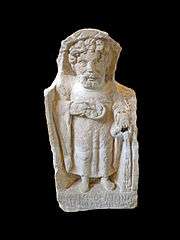Ritona

O.D. T.PRIITONAE. DI VINAE SIVE CA... IONI PRO SALVTE VICANORVM CONTI OMAGUS ENSIVMTER TINIUS MODESTVS F.C.V.S.
Ritona, also known as Pritona, is a Celtic goddess chiefly venerated in the land of the Treveri in what is now Germany. Her cult is attested at Pachten and at Trier, where she "had a carefully built little temple" in the Altbachtal complex.[1] Ritona's temple was one of several in the Altbachtal to include exedrae and courtyards that may have been used to prepare ritual banquets and/or to place offerings.[2] At Pachten her temple also had a theatre, presumably used for performances of a religious nature.[1] A single inscription also honours her at Uzès in southern France.[3]
Her name, related to the same root as Welsh rhyd ‘ford’,[4] suggests that she was a goddess of fords.[5] Jean-Marie Pailler remarks that, "Water crossings required religious precautions that were written into the landscape, toponymy, and ritual: Ritona is thus well at home among the 'crossers' who were the Treveri".[6]
The name variant ‘Pritona’ is directly attested twice: on the goddess's only inscription at Pachten (PRITONAE DIVINAE SIVE CA[...]IONI)[7] and in conjunction with ‘Ritona’ on an inscription from Trier (DEA RITONA PRITONA).[8] ‘Pritona’ is also restored in a further, more fragmentary inscription from Trier (RITO/[NAE] SIVE EX IV[SSV PR]/ITONI[AE?]).[9]
Lothar Schwinden characterizes Ritona as a mother goddess on the basis of the statue of a seated goddess found at Pachten, which he connects with the well-known local type of seated mother goddesses with dogs or babies on their laps (cf. Aveta).[10]

The Pachten inscription specifies that the goddess was invoked by an individual "for the well-being of the townsfolk of Contiomagium" (PRO SALVTE / [V]IKANORVM CONTI/OMAGIENSIVM).[7] A votive sculpture from Crain, depicting a male figure holding an offering-dish and pouring out liquid from a vessel, is dedicated to Minerva and Ritona.[11] On two of the inscriptions from Trier, Ritona is invoked in conjunction either with the numina of the Augusti (see imperial cult)[12] or in honour of the divine house (the imperial family).[13]
References
- 1 2 Edith Mary Wightman (1970). Roman Trier and the Treveri. Rupert Hart-Davis, London. p. 217.
- ↑ John Scheid (1995). "Les temples de l'Altbachtal à Trèves : un "sanctuaire national"?". Cahiers du Centre Gustave Glotz. Editions de Boccard. 6: 236.
- ↑ CIL XII, 02927, retrieved from the Epigraphik-Datenbank Clauss / Slaby on 29 March 2008.
- ↑ The Celtic root *ritu- is thought to derive from the same Indo-European root *pr̻tu- that gives Latin portus 'port' and English 'ford'. Lenka Dočkalová and Václav Blažek (2011). "On Indo-European Roads". The Journal of Indo-European Studies. 39 (3 & 4): 312.
- ↑ Miranda Green (1997). Dictionary of Celtic Myth and Legend. Thames and Hudson Ltd. London.
- ↑ Jean-Marie Pailler (2013). "Mères, Fils et confréries à l'écoute de la Source : témoignages antiques et approche par la toponymie, l'archéologie et l'épigraphie gauloises". AFEAF: 321. Original quote: Les passages de cours d’eau nécessitaient des précautions religieuses inscrites dans le paysage, la toponymie, le rituel : Ritona est ainsi bien à sa place chez les “passeurs” que sont les Trévires.
- 1 2 AE 1959, 00076, retrieved from the Epigraphik-Datenbank Clauss / Slaby on 29 March 2008.
- ↑ AE 1928, 00185, retrieved from the Epigraphik-Datenbank Clauss / Slaby on 29 March 2008.
- ↑ AE 1989, 00547, retrieved from the Epigraphik-Datenbank Clauss / Slaby on 29 March 2008.
- ↑ Lothar Schwinden. "Muttergöttin der Treverer: Ritona". In Sabine Faust et al. (1996) Religio Romana: Wege zu den Göttern im antiken Trier. Rheinisches Landesmuseum Trier.
- ↑ CIL XIII, 02892, retrieved 3 May 2016.
- ↑ AE 1989, 00547, retrieved from the Epigraphik-Datenbank Clauss / Slaby on 29 March 2008.
- ↑ Finke 00030, retrieved from the Epigraphik-Datenbank Clauss / Slaby on 29 March 2008.

